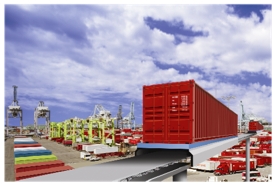As a NASA engineer and father of three, there are two things that I consider important: space exploration and climate change. Unfortunately, neither space nor climate change are receiving the attention they deserve from policy makers and the public. Fortunately, my 30-year career at NASA has given me the opportunity to become involved in both.
At NASA, I have had the privilege of working on a variety of space missions, from Hubble Space Telescope deployment to the final shuttle Columbia mission, from robotic missions to the moon to human exploration of Mars. I have also had the opportunity to combine my engineering expertise with my life-long “hobby” of environmental conservation. This has included developing state-of-the art technologies that merge space technology, transportation, and sustainability.
 It’s not just rocket science
It’s not just rocket science
Specifically, about ten years ago, I led a multidisciplinary team of engineers and scientists involved in what has been termed electromagnetic launch (EML) technology. The purpose of EML is to “assist” in launching spacecraft horizontally, on a track propelled by linear motors. Accelerating the vehicle prior to release via EML reduces the amount of propellant required for launch, thereby increasing mass-to-orbit capability (which basically means launching more stuff to orbit with less fuel).
Although this technology has been used for decades in high-speed maglev transportation systems, particularly in Asia, its public application in the U.S. has been relegated to amusement park rides. The application of this technology to EML for space launch assist, however, had never been developed or tested before. Multiple engineering issues, such as aerodynamics, structural integrity, thermal transfer, and power storage had to be considered. Nevertheless, as part of a NASA technology development program, a few of us on the EML team designed and built a prototype linear motor that was tested to over 159 miles per hour–in only 18 feet.

Maglev train near Pudong International Airport, Shanghai
From space to the everyday
Besides their revolutionary application for launching spacecraft, linear motors also have many potential “terrestrial” applications. For example, the Navy has developed an electromagnetic system on a new aircraft carrier to replace traditional steam catapults.
Since linear motors can translate a simple conductive plate, it is not a significant leap to imagine such a system built into highways to propel vehicles without fuel. In fact, a nationwide network of linear motors on interstates could conceivably enable unlimited range for electric vehicles (EVs), which would only require battery power for local travel. At a minimum, linear motors could help reduce the fuel or battery power needed to accelerate any vehicle to cruising speed, for example, at entrance ramps or on uphill grades. Combined with regenerative braking, whereby power is generated through electromagnetic deceleration and put back into the grid, this would create a more sustainable highway transportation system.
Beyond highways, airport taxiways are prime candidates for embedded linear motors that could propel aircraft equipped with retractable skids, reducing the amount of jet fuel burned prior to takeoff. If applied to transporting freight at ports, as one of our EML partners has proposed, linear motors could reduce emissions and improve local air quality.
What’s holding us back?
Despite its advantages, electromagnetic transport has not gained much support in either the aerospace or transportation communities. Much has to do with the perception that such “out-of-the-box” technologies are “Buck Rogers” ideas, akin to space elevators, power beaming, and other unproven technologies.

Cargo LIM diagram is courtesy of General Atomics.
Further, although NASA’s ever-shrinking budget is only a fraction-of-a-percent of the national budget, the agency is always scrutinized for program cost-effectiveness while having to uphold high expectations for mission success. Because of this, revolutionary and unfamiliar technologies like EML tend to be dismissed in favor of those already close to being “ready for prime-time.” As it is, our work on EML has not been funded in recent years.
Of course, one of the biggest challenges is that this technology depends on an expanded electric power infrastructure, which is a “chicken-or-the-egg” problem. Unlike the early automobiles that could travel on unpaved roads, electromagnetic transport requires infrastructure that has yet to be built. But unless there is sufficient demand, development is difficult to justify.
Towards a sustainable future
This technology has the unique advantage of finally enabling a zero-emission transportation system, since it would allow both electric and internal-combustion vehicles to operate without fuel. Unfortunately, implementation of such a grand vision would require large-scale deployment of renewable power generation— something unlikely to occur in the near future, at least in the U.S.
Despite our current “business-as-usual” approach to transportation, my hope is that as a “free” society, we will eventually aspire to a more visionary and sustainable approach to how we get from Point A to Point B. Only this way can we be truly “free” to live our lives more efficiently, safely, and sustainably.
—
Science Network Voices gives Equation readers access to the depth of expertise and broad perspective on current issues that our Science Network members bring to UCS. To learn more about our Clean Vehicles Program, click here.
